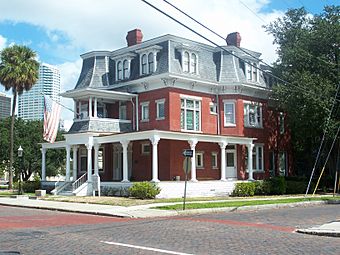Hutchinson House (Tampa, Florida) facts for kids
Quick facts for kids |
|
|
Hutchinson House
|
|
 |
|
| Location | 304 Plant Ave., Tampa, Florida United States |
|---|---|
| Area | less than one acre |
| Built | 1908 |
| Architectural style | Second Empire |
| NRHP reference No. | 77000404 |
| Added to NRHP | November 1, 1977 |
The Hutchinson House is a super cool historic home in Tampa, Florida, United States. It was finished in 1908. This three-story brick building has a special look called Second Empire architecture. You'll notice its tall, sloped roof and a big porch with fancy Corinthian columns.
Currie J. Hutchinson, a local business owner, built this house. It's one of the few buildings of its kind in Florida. Because it's so special, it was added to the U.S. National Register of Historic Places on November 1, 1977. You can find it at 304 Plant Avenue.
Contents
A Look Back: The Hutchinson House Story
The Hutchinson House was built by Mr. Currie Hutchinson. Work on the house started in 1906 and it was ready by 1908. Most of the building materials came all the way from Ohio, Mr. Hutchinson's home state. The way the bricks were put together was very unique. This made the lines between the red bricks super tight and neat.
The outside walls of the house are about 18 inches thick. That's like two rulers put together! Even though it's less than a quarter-mile from Tampa Bay, the basement has stayed dry for over 100 years. The house also has five working fireplaces. Three are on the first floor, two on the second, and there's a stove in the basement. Building the house cost about $6,500 back then. That was a huge amount of money!
The Hutchinson family lived in the house for a while. Mr. Hutchinson ran his pharmacy in downtown Tampa.
What Was the House Used For?
After the family lived there, the Hutchinson House became a hospital. This was from about 1932 to 1946. Then, it was used as a place where people could rent rooms until 1958. After that, it became a fraternity house for the Pi Kappa Phi group. It stayed a fraternity house until 1977. The University of Tampa asked all fraternities to leave campus, and the Hutchinson House was left empty and in rough shape.
The University of Tampa then sold the house to the City of Tampa. The city later sold it to the Tampa Preservation Society. This group started a big project to fix up the building. Their restoration work lasted for about two years.
In 1980, a lawyer named William B. Plowman started talking about buying the house. He bought it in 1981 and kept working on its restoration. He made improvements to all three floors. He even found a way to make the third floor easier to reach without changing the house's original design. All the historical details were carefully kept during these repairs.
In 1989, Matt Powell rented space from Mr. Plowman. Matt loved the building so much that he convinced Mr. Plowman to let him take care of it in 1999. Matt Powell eventually bought the historic building. He has continued to protect, restore, and keep this amazing house in great condition.
The Unique Second Empire Style
One of the most interesting things about the Hutchinson House is its special architectural style. It's built in the "Second Empire" style. You can see this in the third-floor walls, which are actually inside the unique roof. This roof is called a mansard roof and is made of slate. Each slate shingle was cut by hand! These shingles have lasted over a century. The Hutchinson House has survived 100 years of hurricanes, hot weather, and cold, and it's still in excellent shape.
Second Empire is a building style that was popular during the Victorian era. It was most popular between 1865 and 1880. It got its name because it used "French" design ideas that were popular during the time of the Second French Empire. A famous example of this style is the Opera Garnier in Paris, France. In the United States, Second Empire buildings often have a steep mansard roof. This roof is the main clue to its French roots. Sometimes, a tower element would be as tall as the top floor, just like at the Hutchinson House. The top of the mansard roof often had decorative iron trim.
The Hutchinson House also has three tall chimneys. They stick up 10 feet above the roof! These chimneys are connected to the five fireplaces and the stove inside the house.
In 2007, a copy of the original gas lantern was put back in the front yard. There was also a stone, called the Hutchinson House Stone, that was used as a step. This made it easier for people to get on and off their horses.
Why It's a Landmark
The Hutchinson House has been a historical landmark since 1977. The United States Department of the Interior decided it should be protected. They looked at its unique architecture, its age, and how well it had been kept. They agreed it was important enough to be preserved as a historical landmark for everyone to enjoy.



